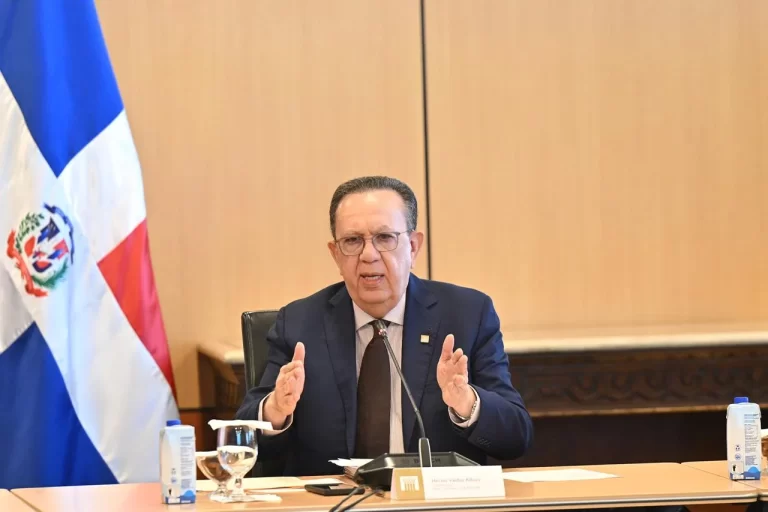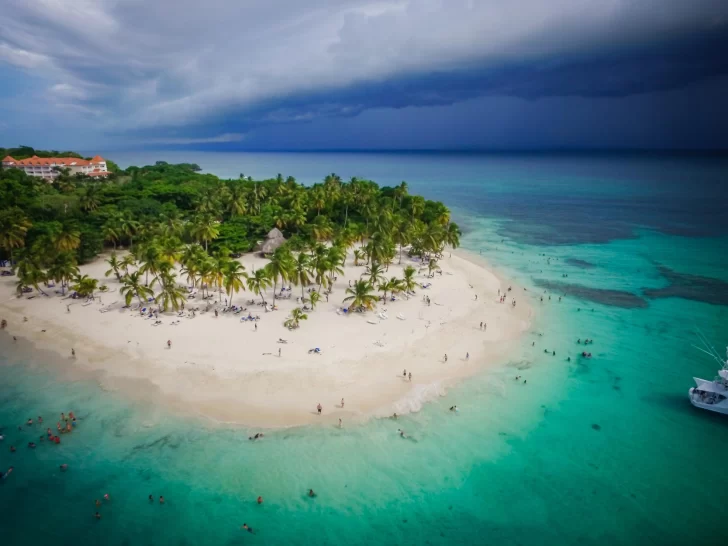El gobernador del Banco Central (BCRD), Héctor Valdez Albizu, realizó una disertación en el marco de un ciclo de videoconferencias sobre Centroamérica y el Caribe organizado por el Bank of America Securities, el cual está dirigido a los gerentes de importantes bancos y fondos de inversión a nivel global.
Durante su alocución virtual, Valdez Albizu hizo un repaso a la implementación de las medidas monetarias para enfrentar el impacto del covid-19 y ofreció información clave sobre las perspectivas de República Dominicana, destacando que será la economía de la región que más rápido se recuperará de la crisis originada por la pandemia, apoyada en sus fuertes fundamentos y su probada capacidad de resiliencia.
Reducción histórica de la tasa de interés
En su exposición, el gobernador señaló la reducción a un nivel histórico de la tasa de política monetaria, al disminuir de 150 puntos básicos, desde 4.50% a 3.00% anual.
Asimismo, informó que se ha implementado el plan de estímulo monetario más amplio de Centroamérica y el Caribe, al proveer liquidez en moneda nacional por unos RD$190 mil millones (más del 4% del PIB), que ha contribuido a dinamizar el crédito privado, además de incentivar el refinanciamiento a tasas de interés más bajas y plazos más favorables para los deudores afectados por la crisis.
A tal efecto, se han desembolsado a la fecha unos RD$144 mil millones a los hogares y a sectores estratégicos como la construcción, el turismo, la manufactura, el comercio y las mipymes, beneficiándose aproximadamente a 54 mil sujetos de crédito.
Estabilidad de precios y en el mercado cambiario
Valdez Albizu comunicó que la inflación acumulada a septiembre fue de 3.74%, mientras que la inflación anualizada a septiembre se situó en tono al 5%, influenciada por choques transitorios en la producción de algunos alimentos afectada por la sequía a inicios de año y luego por las tormentas tropicales Isaías y Laura.
En ese sentido, explicó que los pronósticos del Banco Central y las expectativas de los agentes económicos señalan que la inflación convergería al centro del rango meta de 4.0% +/- 1.0% durante el año 2021, otorgando el espacio suficiente para que se mantengan condiciones monetarias favorables que impulsen de la demanda interna.
Entre sus valoraciones, el gobernador fue enfático en señalar a los inversionistas internacionales que “el BCRD no espera presiones cambiarias adicionales, ni para lo que resta de 2020, ni tampoco para el próximo año 2021, cuando las actividades generadoras de divisas continuarán mejorando”.
Asimismo, destacó la participación activa del Banco Central en el mercado cambiario en los momentos de mayor incertidumbre por la pandemia que, sumado al dinamismo de las remesas y la mejoría reciente de las exportaciones, han sido claves para mantener la estabilidad relativa del tipo de cambio.
Tendencia sostenida de recuperación
Sobre la reactivación económica, el gobernador Valdez Albizu informó que en el mes de septiembre la variación interanual del Indicador Mensual de la Actividad Económica (IMAE) fue -5.6%, registrando una mejoría sustancial de 24.2 puntos porcentuales comparada con el -29.8% de abril, es decir, una caída 5 veces menor con respecto al momento económico más crítico debido a la pandemia.
Hacia adelante, se espera que la economía continúe mejorando de forma sostenida conforme se consolide la recuperación de los sectores productivos, impulsada por las medidas de flexibilización del Banco Central y en coordinación con la política fiscal del Gobierno.
En ese sentido, Valdez Albizu destacó la labor titánica que está realizando el Presidente de la República Luis Abinader y su equipo de gobierno para promover la inversión extranjera, propiciar una rápida recuperación del turismo y apuntalar la ejecución de proyectos claves a través de las Alianzas Públicas Privadas, como es el caso de la carretera del Ámbar, que unirá a Santiago de los Caballeros y Puerto Plata, así como el desarrollo del Puerto de Manzanillo como centro logístico y de comercio exterior para toda la región norte.
Asimismo, indicó que la reactivación de la inversión pública a través de la ejecución de proyectos de infraestructura vial, como la ampliación y readecuación de carreteras y la construcción de las vías de circunvalación de Baní y Azua, contribuirán a dinamizar el importante sector de la construcción, clave por su efecto multiplicador sobre el resto de las actividades productivas.
La implementación de estas políticas económicas, junto a la normalización paulatina del turismo, permitirán que se acelere el proceso de recuperación económica durante el año 2021, registrando un crecimiento económico superior al 6.0%, mayor a su potencial, en un contexto de fuertes fundamentos y del mantenimiento de la estabilidad macroeconómica.
“Esta es una economía en cuyo futuro se puede apostar e invertir por su probada capacidad de resiliencia”, dijo el gobernador.
Desempeño del sector externo mejor al previsto.
Valdez Albizu indicó que la balanza de pagos muestra la gran capacidad de resiliencia del país, resaltando el dinamismo de las remesas que crecieron durante octubre en 36.1% interanual y alcanzan unos US$6,639 millones durante enero-octubre.
Asimismo, informó que las empresas de zonas francas se encuentran operando en más de un 90% de capacidad y que sus exportaciones aumentaron en 9.8% durante septiembre. Como resultado de este desempeño positivo, se espera cerrar el año 2020 con un déficit de cuenta corriente en torno a 3.0% del PIB, mientras se proyecta un déficit aproximado de 2.5% del PIB para el año 2021.
Por otro lado, señaló que la inversión extranjera directa sigue fluyendo al país, alcanzando US$2,066 millones en enero-septiembre, monto que permite financiar más de dos meses el déficit registrado de cuenta corriente.
El Banco Central prevé que la inversión extranjera cierre el año en torno a los US$2,500 millones, que es el promedio de la última década, reflejando la confianza de los inversionistas en la capacidad de la economía dominicana para enfrentar con éxito los retos derivados del actual entorno complejo y convulso.
Fuente: Periódico El Dinero[:en]The Governor of the Central Bank (BCRD), Héctor Valdez Albizu, gave a speech in the framework of a cycle of videoconferences on Central America and the Caribbean organized by the Bank of America Securities, which is aimed at managers of important banks and funds of investment globally.
During his virtual address, Valdez Albizu reviewed the implementation of monetary measures to face the impact of COVID-19 and offered key information on the prospects for the Dominican Republic, highlighting that it will be the economy of the region that will recover the fastest from the crisis caused by the pandemic, supported by its strong foundations and its proven capacity for resilience.
Historical interest rate reduction
In his presentation, the governor pointed out the reduction to a historical level of the monetary policy rate, by decreasing 150 basis points, from 4.50% to 3.00% annually.
Likewise, it reported that the broadest monetary stimulus plan in Central America and the Caribbean has been implemented, by providing liquidity in national currency for about RD $ 190 billion (more than 4% of GDP), which has helped to boost private credit, in addition to encouraging refinancing at lower interest rates and more favorable terms for debtors affected by the crisis.
To this end, some RD $ 144 billion have been disbursed to date to households and to strategic sectors such as construction, tourism, manufacturing, commerce, and MSMEs, benefiting approximately 54 thousand subjects of credit.
Price stability and in the foreign exchange market
Valdez Albizu reported that accumulated inflation to September was 3.74%, while annualized inflation to September stood at 5%, influenced by transitory shocks in the production of some foods affected by the drought at the beginning of the year and later by tropical storms Isaías and Laura.
In this sense, he explained that the forecasts of the Central Bank and the expectations of economic agents indicate that inflation would converge to the center of the target range of 4.0% +/- 1.0% during the year 2021, giving enough space for conditions to be maintained. favorable monetary policies that drive domestic demand.
Among his assessments, the governor was emphatic in pointing out to international investors that «the BCRD does not expect additional exchange pressure, neither for the remainder of 2020 nor for the next year 2021, when foreign exchange generating activities will continue to improve.»
Likewise, he highlighted the active participation of the Central Bank in the exchange market at times of greatest uncertainty due to the pandemic which, added to the dynamism of remittances and the recent improvement in exports, have been key to maintaining the relative stability of the exchange rate.
Sustained recovery trend
Regarding the economic reactivation, Governor Valdez Albizu reported that in the month of September the interannual variation of the Monthly Indicator of Economic Activity (IMAE) was -5.6%, registering a substantial improvement of 24.2 percentage points compared to -29.8% in April, that is, a 5 times smaller drop compared to the most critical economic moment due to the pandemic.
Going forward, the economy is expected to continue to improve steadily as the recovery of the productive sectors consolidates, driven by the Central Bank’s easing measures and in coordination with the Government’s fiscal policy.
In that sense, Valdez Albizu highlighted the titanic work that the President of the Republic Luis Abinader and his government team are doing to promote foreign investment, promote rapid recovery of tourism and support the execution of key projects through Public Alliances Private, as is the case of the Ámbar highway, which will link Santiago de los Caballeros and Puerto Plata, as well as the development of the Port of Manzanillo as a logistics and foreign trade center for the entire northern region.
He also indicated that the reactivation of public investment through the execution of road infrastructure projects, such as the expansion and readjustment of highways and the construction of the Baní and Azua ring roads, will contribute to boosting the important construction sector. , key due to its multiplier effect on the rest of the productive activities.
The implementation of these economic policies, together with the gradual normalization of tourism, will allow the economic recovery process to accelerate during 2021, registering an economic growth of more than 6.0%, higher than its potential, in a context of strong fundamentals and the maintenance of macroeconomic stability.
«This is an economy whose future you can bet on and invest in because of its proven resilience,» said the governor.
Performance of the external sector better than expected.
Valdez Albizu indicated that the balance of payments shows the country’s great resilience capacity, highlighting the dynamism of remittances that grew 36.1% year-on-year during October and reached about US$6,639 million during January-October.
It also reported that free zone companies are operating at more than 90% capacity and that their exports increased by 9.8% during September. As a result of this positive performance, it is expected to close 2020 with a current account deficit of around 3.0% of GDP, while an approximate deficit of 2.5% of GDP is projected for the year 2021.
On the other hand, he pointed out that direct foreign investment continues to flow into the country, reaching US$2,066 million in January-September, an amount that allows financing the registered current account deficit for more than two months.
The Central Bank foresees that foreign investment will close the year at around US$2,500 million, which is the average of the last decade, reflecting the confidence of investors in the capacity of the Dominican economy to successfully face the challenges derived from the current complex and convulsive environment.
Source: El Dinero Newspaper
[:]





